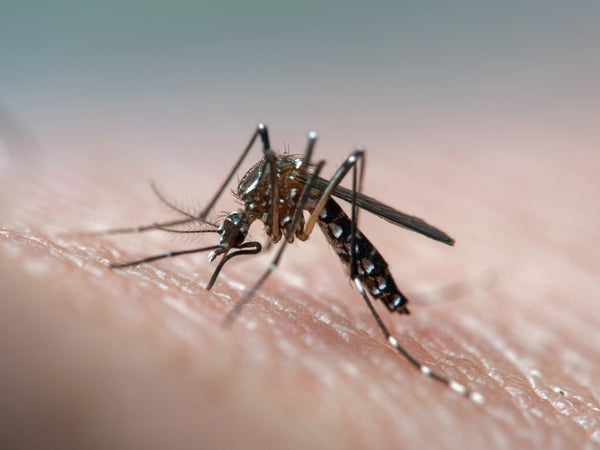This article was published in Scientific American’s former blog network and reflects the views of the author, not necessarily those of Scientific American
Vector-borne diseases, those carried by organisms that can transmit them between humans or from animals to humans, account for more than 17 percent of all infectious diseases. The most commonly known vector, the mosquito, carries some of the deadliest diseases of this kind, including dengue fever, Zika virus, malaria, chikungunya virus, West Nile virus and yellow fever. More than half of the world’s population in more than 128 countries—from Vietnam to Sudan, the Caribbean and the U.S.—are at risk for contracting a vector-borne illness.
Dengue fever alone accounts for 96 million cases a year. In fact, Thailand reported a staggering 20,000 cases of dengue fever in just the first five months of 2019. More than half of those infected were children. Thailand’s public health ministry has explained that the rainy season, along with a new school semester, makes children the most vulnerable and has urged parents and teachers to take preventive measures against mosquitoes.
Also known as breakbone fever, dengue can cause debilitating muscle, joint, or bone pain and is typically transmitted by the Aedes aegypti or A. albopictus mosquito, both of which feed on their hosts in indoor and outdoor environments, during daylight and evening hours. Common indoor prevention tactics include ensuring window screens are on every window and having bed nets around every bed, while outdoor prevention includes using insect repellent when going outside, wearing light-colored clothing and getting rid of any stagnant water inside of, and around, the home.
On supporting science journalism
If you're enjoying this article, consider supporting our award-winning journalism by subscribing. By purchasing a subscription you are helping to ensure the future of impactful stories about the discoveries and ideas shaping our world today.
Because dengue fever and other vector-borne diseases, including Zika virus, are common across Southeast Asia, mosquito prevention is urged not only by Thailand’s health ministry but also by pillars of the science and technology community in the country who host the annual National Science and Technology Fair, with attendees from all over the world.
The largest event of its kind in Thailand, the fair provides various exhibition and seminar offerings that attract a diverse group of people—from children and families to university students and adults—making it an excellent atmosphere to educate citizens on public health matters such as vector-borne diseases.
In 2016 the National Science Museum of Thailand (NSM) created an exhibition for the fair called Living with Mosquitoes. This exhibition promotes awareness of vector-borne illnesses and protection from mosquitos through an interactive design meant to engage visitors via participation in educational games and walk-through displays.
Ever wondered how mosquitoes find us? The exhibit gives visitors an interactive look at the carbon dioxide detection, as well as the heat and movement detection, the insects use to locate prey. A second game delves into mosquito reaction time. Visitors learn that while their flight speed is quite low, their reaction time is impressively fast, explaining how they can avoid our slap.
Traditionally, schools in Thailand teach students about mosquito-borne diseases and the ways to protect themselves via books. Wanting to break away from this style of learning, science communicators at NSM conducted extensive content research to develop a story line for the exhibit and then worked with a team to create the conceptual design of how it would come to life.
The result yielded an exhibition with interactive games, giant models of mosquitoes, and live mosquito larvae and pupae, facilitating a hands-on experience. The feedback from the students showed they were eager to learn more and, importantly, demonstrated the exhibits can stimulate their curiosity, which could help them to keep discovering on their own.
The museum’s mosquito-awareness efforts expand past the exhibition. Working with the Smithsonian Science Education Center—a Washington D.C.-based organization focused on science education for children in grades K–12—a translation of the report Mosquito! Community Research Guide into Thai is underway so it may be used as a prevention tool in Thailand’s schools. Like the interactive tactic of the exhibition, the hope is that the report will engage students in a way that encourages them to experience scientific inquiry, rather than simply reading about it, by providing opportunities for them to get involved in the actual process of conducting work.
Creators of these educational tools are optimistic that innovative mosquito-borne disease awareness practices will be adopted across borders to meet country-specific needs without disrupting the interactive experience. This could mean a focus on malaria in Africa or on Zika in the Caribbean. Nevertheless, the exhibition conveys the reality of mosquito-borne disease prevention, and that is helpful, no matter which country visitors reside in.
Vector-borne disease affects all corners of the globe. Thanks to the efforts of public health, science and technology facilitators, organizations such as NSM and the Smithsonian Science Education Center are participating in a transcontinental, collaborative effort in community education and prevention. By working together without boundaries, these organizations are establishing the path to relieving the at-risk population of mosquito-borne disease.
For more information on vector-borne diseases and prevention tips, visit the Web site of the U.S. Centers for Disease Control and Prevention and the Environmental Protection Agency.
